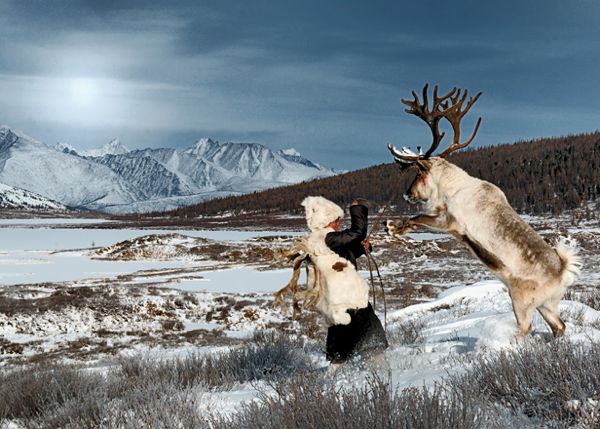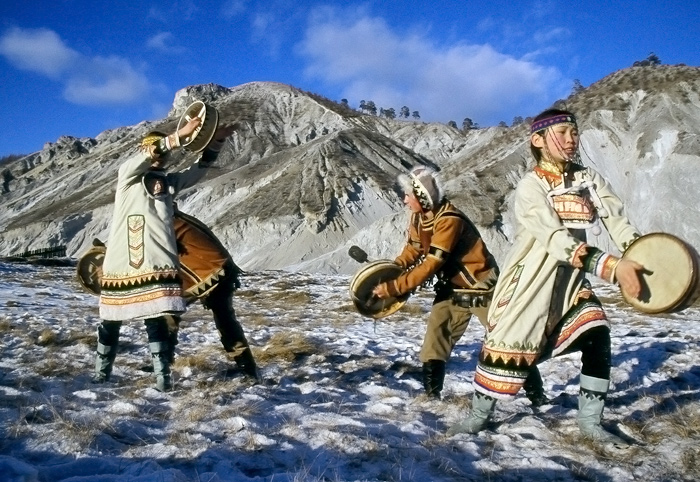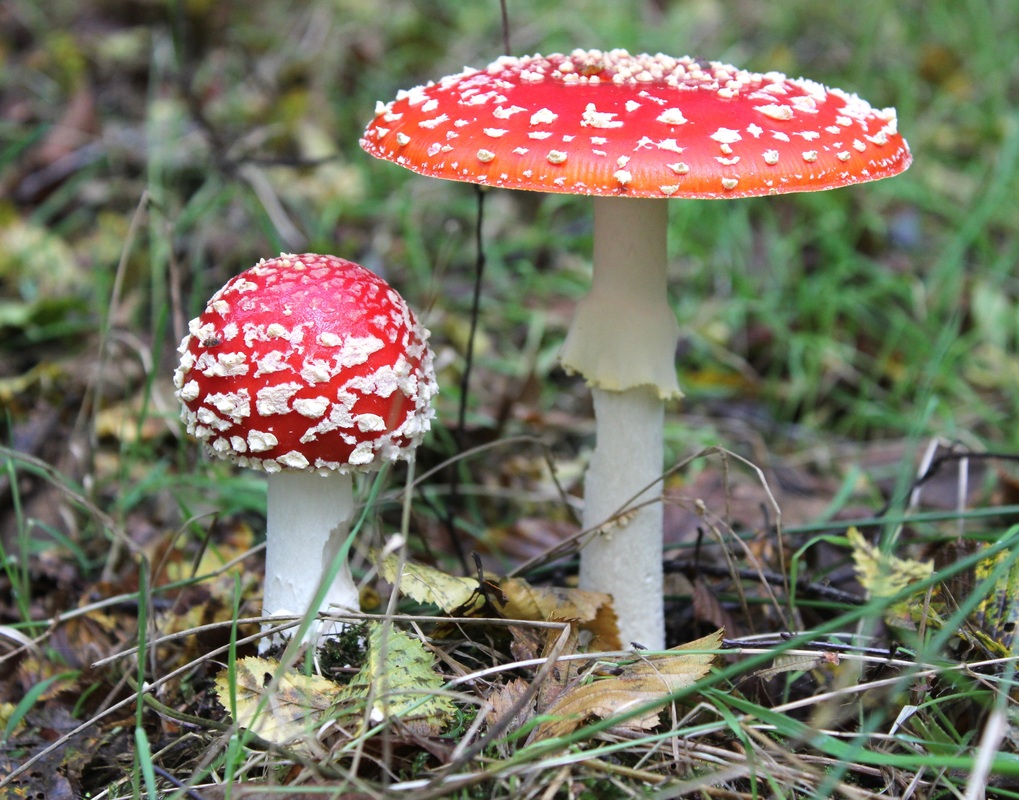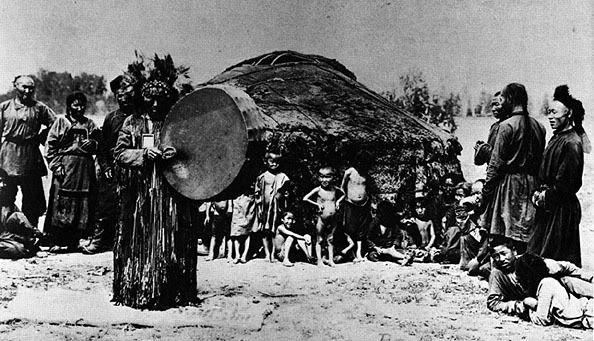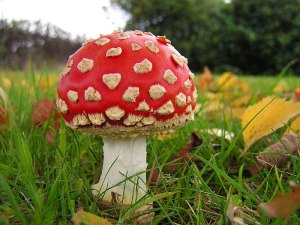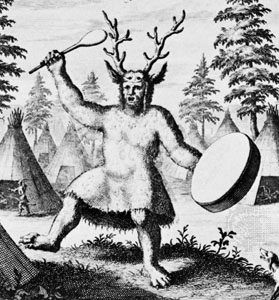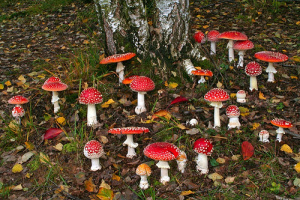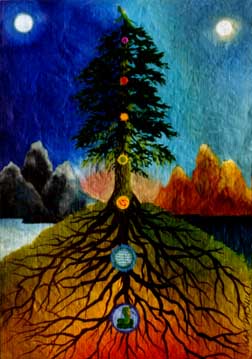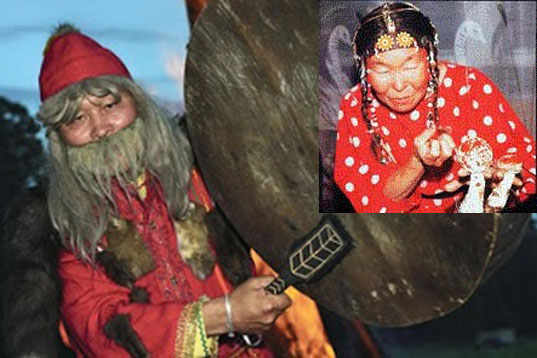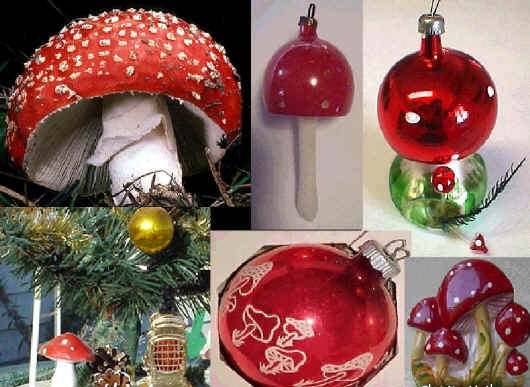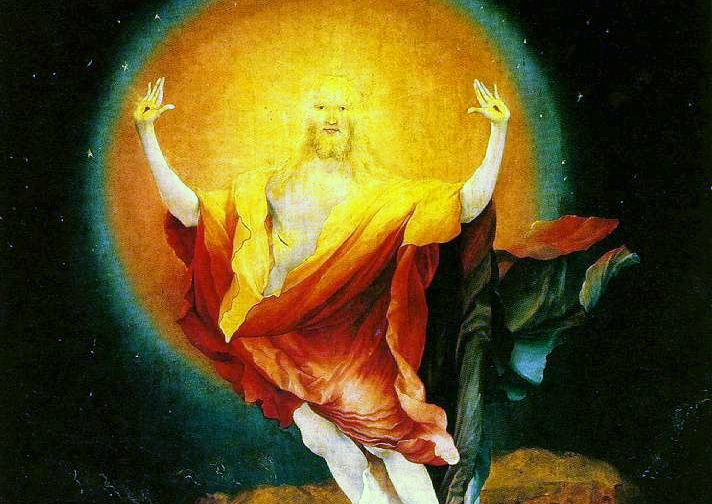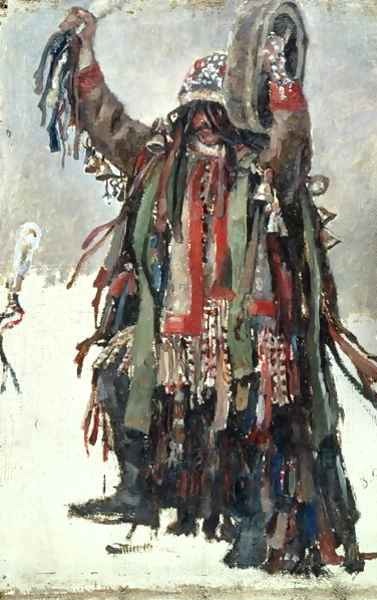Noël chamanique
Article en anglais et en français
avec l’aimable autorisation de Minthé, la Chamane de l’Eau.
Have you ever wondered why in modern Christmas tradition we do the things we do? What is the origin of the Christmas tree, with the star on top, decorations about, and all the brightly wrapped presents beneath? Or the idea behind Santa Claus who jets around the globe in a magic sleigh with flying reindeer – defying both time and space – to deliver the world’s children a bounty of Christmas gifts? And since when did Santa and the birth of Jesus have anything to do with each other? Where do these stories come from – and better yet: what are we actually celebrating on Christmas morning?
Vous êtes-vous jamais demandé pourquoi dans la tradition de Noël moderne, nous faisons les choses que nous faisons ? Quelle est l’origine de l’arbre de Noël, avec l’étoile sur le dessus, les décorations tout autour, et tous les cadeaux brillants dessous ? Ou l’idée derrière le Père Noël qui vole autour du monde sur un traîneau magique avec des rennes volants – défiant le temps et l’espace – pour livrer aux enfants du monde des cadeaux de Noël ? Et depuis quand le Père Noël et la naissance de Jésus ont quelque chose en commun ? D’où viennent ces histoires – et mieux encore : ce que nous célébrons en fait le matin de Noël ?
There are answers to these questions. And the history is not so farfetched or even that hidden. You just have to know where to look. And the first place we look is the North Pole; seriously – in ancient Siberia, near the top of the world. The story of Santa and his likely origins begins where he supposedly lives: the frigid North.
Il y a des réponses à ces questions. Et l’histoire n’est pas si farfelue ou même tellement cachée. Vous avez juste à savoir où chercher. Et la première place où regarder est le pôle Nord ; sérieusement – dans l’ancienne Sibérie, près du sommet du monde. L’histoire de Père Noël et ses origines probables commence là où il vit prétendument: le Nord glacial.
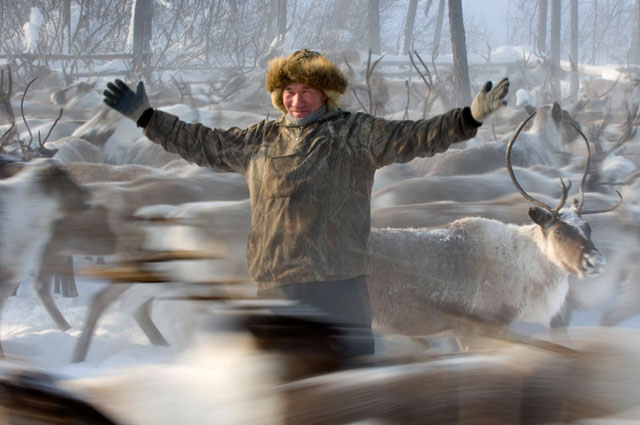
In this wintry-wonderland, if you go searching for Santa, you may not find him or his Elvin factory – but you will find groups of indigenous people native to what we know as Siberia. Among these cultures are the northern Tungusic people, known as the Evenki. The Evenki were predominantly hunter-gatherers as well as reindeer herders. Their survival depended largely upon the health and vitality of their domesticated reindeer. The reindeer provided the Evenki and other northern tribes with everything from clothing, housing material, wares and tools from the bones and antlers, transportation (yes, they ride reindeer!), milk, as well as cultural and religious inspiration.
Dans ce pays des merveilles hivernales, si vous chercher après le Père Noël, vous ne trouverez ni lui ni son usine de lutins – mais vous trouverez des groupes de populations natives indigènes de ce que nous savons de la Sibérie. Parmi ces cultures sont les nordiques Toungouses, connus sous le nom de Evenki. Les Evenki étaient principalement des chasseurs-cueilleurs ainsi que des éleveurs de rennes. Leur survie dépendait en grande partie de la santé et de la vitalité de leurs rennes domestiqués. Le renne a fourni aux Evenki et à d’autres tribus du nord les vêtements, le matériel pour le logement, le matériel et les outils en os et en bois, le transport (oui, ils montaient les rennes !), le lait, ainsi que l’inspiration culturelle et religieuse.
The Evenki were also a shamanic culture. The word “shaman” actually has its roots in the Tungus word saman which means “one who knows or knows the spirits.” Many of the classic shamanic characteristics that would later be reflected in cultures all over the world were originally documented by Russian and European explorers while observing the Tungus and related people’s religious life. This includes the three-world system, the shamanic journey or soul flight, the use of altered states of consciousness, animistic belief in spirit, and so forth.
Les Evenki étaient aussi une culture chamanique. Le mot « chaman » employé aujourd’hui a ses racines dans le mot Saman Tungouse qui signifie « celui qui sait ou connaît (les esprits) ». Bon nombre des caractéristiques classiques chamaniques qui allaient plus tard être reflétées dans les cultures du monde entier ont été initialement rapportées par des explorateurs russes et européens qui observèrent les Toungouses et la vie religieuse des gens autour. Cela inclut le système des trois mondes, le voyage chamanique ou voyage de l’âme, l’utilisation des états modifiés de conscience, la croyance animiste en l’esprit, et ainsi de suite.
A significant aspect of the shamanism practiced in this part of the world during that time was linked to Amanita muscaria, also known as the Fly Agaric mushroom. This mushroom is more widely accepted in the modern world as the Alice in Wonderland mushroom. It was held very sacred by these ancient people, and was used by the shaman and others for ceremonial and spiritual purposes. Amanitas – as you can tell by the pictures – range from brightly red and white to golden orange and yellow. They only grow beneath certain types of evergreen trees. They form a symbiotic relationship with the roots of the tree, the exchange of which allows them to grow. One of the reported ancient beliefs was that the mushroom was actually the fruit of the tree. Due to the lack of seed, it is also commonly held that Fly Agaric was divine – a kind of virginally birthed sacred plant.
Un aspect important du chamanisme pratiqué dans cette partie du monde à cette époque a été liée à l’Amanita Muscaria, aussi connue comme le champignon amanite tue-mouche (intéressant : en anglais fly est utilisé pour « mouche » mais aussi pour le verbe « voler » (planer)). Ce champignon est plus largement connu dans le monde moderne comme le champignon d’Alice au Pays des merveilles. Il était considéré comme très sacré par ces peuples anciens, et était utilisé par le chaman et d’autres, à des fins cérémonielles et spirituelles. Les amanites – comme vous pouvez le voir sur les photos – vont depuis des couleurs vives rouges et blanches jusqu’à l’orange ou le jaune d’or. Elles ne poussent que sous certains types d’arbres à feuilles persistantes. Elles créent une relation symbiotique avec les racines de l’arbre, ce qui leur permet de se développer. Une des anciennes croyances rapportées était que le champignon était en fait le fruit de l’arbre. En raison du manque de semences, il est également généralement accepté que l’amanite tue-mouche était divine – une sorte de plante sacrée née virginalement.
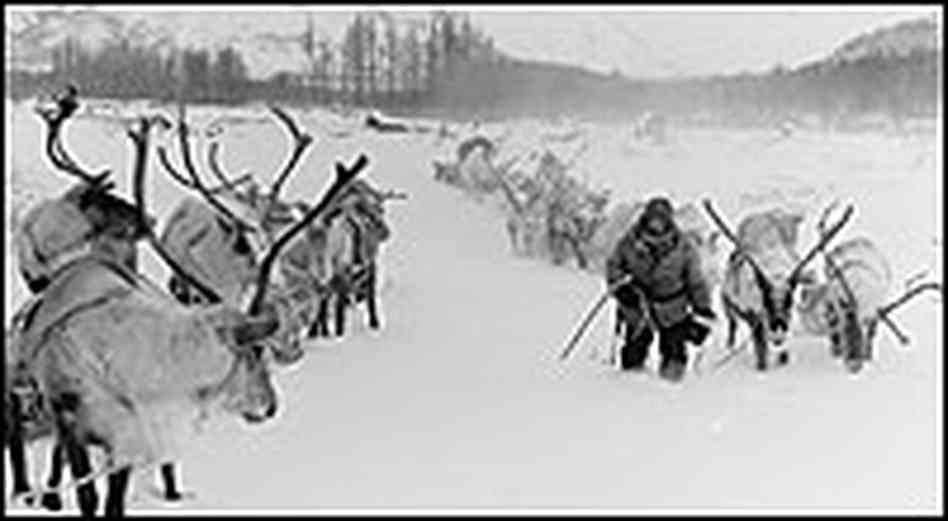
Although intensely psychoactive, Amanitas are also toxic. One way to reduce the toxicity and increase the psychoactive potency was to simply dry them. When out collecting the mushrooms, people would pick a bunch of them under the evergreen trees and lay them out along the branches while continuing to pick the mushrooms beneath other trees. The result was something that looked very reminiscent of a modern Christmas tree: evergreen trees whose branches are dotted with bright red, roundish “decorations” – in this case the sacred mushrooms. At the end of the session, the shaman or harvester would go around to each of their mushroom stashes and put them all in one large sack… a large sack?!! Remind you of anything?! Not only this, as the story of the tradition goes, the shaman would then, carrying this large sack, visit the homes of his or her people and deliver the mushrooms to them. They would then continue the drying process by hanging them in a sock, near the fire!
Outre d’être puissamment psychoactives, les amanites sont également toxiques. Une façon de réduire la toxicité et d’augmenter la puissance psychoactive était simplement de les sécher. Lorsqu’ils sortaient pour ramasser les champignons, les gens choisissaient un tas d’entre eux sous les arbres à feuilles persistantes et les étalaient sur les branches tout en continuant à chercher les champignons sous d’autres arbres. Le résultat était quelque chose qui ressemblait très fort à un arbre de Noël moderne : arbres à feuilles persistantes, dont les branches sont parsemées de « décorations » rondes rouge vif – dans ce cas les champignons sacrés. À la fin de la session, le chaman irait autour de chacune de leurs cachettes de champignons et les mettrait tous dans un grand sac … un grand sac? !! Ca vous rappelle quelque chose ?! Et ce n’est pas fini, selon l’histoire de la tradition, le chaman allait alors, portant ce grand sac, visiter les maisons de son peuple et leur livrer les champignons. Ils allaient ensuite poursuivre le processus de séchage en les suspendant dans une chaussette, près du feu !
Another way to reduce the toxicity of the sacred mushrooms is through human filtration. Once passed through the body, the toxic elements are apparently filtered by the liver and the resultant urine that comes out contains the still intact psychoactive elements. So they drank the filtered urine. But that’s only half the story. Somewhere in the mythic origins of this practice is the reindeer. Because the reindeer also love these mushrooms. They dig through the snow to eat them, and they also drink their own urine afterwards. So perhaps, long ago, one of the first shamans witnessed the reindeer’s love affair with this peculiar mushroom – as well as its propensity for eating its own freshly yellowed-snow – and saw how peculiarly it behaved as the romance heated up. The curiosity (indeed a hallmark characteristic of a shaman) couldn’t be contained, and the shaman did what he had to do: he first ate some of the yellow snow himself… and without a doubt realized the profound wisdom and magic not only in the mushroom, but in the reindeer. And so this romance, too, began…
Une autre façon de réduire la toxicité des champignons sacrés est par filtration. Une fois passé à travers le corps, les éléments toxiques sont apparemment filtrés par le foie, et l’urine qui en résulte contient les éléments psychoactifs encore intacts. Donc, ils ont bu l’urine filtrée. Mais ceci est seulement moitié de l’histoire. Quelque part dans les origines mythiques de cette pratique, il y a le renne. Parce que les rennes aiment aussi ces champignons. Ils creusent dans la neige pour les manger, et ils boivent aussi leur propre urine après. Alors peut-être, il y a longtemps, l’un des premiers chamans a été témoin de l’histoire d’amour entre le renne avec ce champignon particulier – ainsi que sa propension à manger sa propre neige fraîchement jaunie – et vu comment il s’est comporté. La curiosité (en effet c’est une caractéristique particulière du chaman) ne pouvait être contenue, et le chaman a fait ce qu’il avait à faire : il a d’abord mangé une partie de la neige jaune lui-même … et sans doute réalisé la profonde sagesse et la magie non seulement dans le champignon, mais aussi dans le renne. Et la romance a commencé …
However it may have happened in antiquity, the connection between the reindeer, the mushroom and the shamanism is apparent. A very common vision that one has while under the influence of Fly Agaric is precisely that: flying. Massive distortions of time and space occur, affecting scale in dramatic ways. Not only do you observe yourself flying, but also other things… like reindeer. It is not that difficult to connect the dots here. Shamanic people are deeply invested in their environment. They learn the magical and mystical properties of the natural world, and often assign a great deal of importance and sacredness to the bearers of that magic. For some of these ancient Siberian people, this power was charioted by the reindeer and the sacred mushroom. That the reindeer should have the ability to fly is evident not only in the vision, or their clearly altered state once intoxicated, but also in the wisdom they offered to the shamans by eating the mushroom in the first place, and for guiding them to do so just the same.
Quoi qu’il se soit produit dans l’antiquité, la connexion entre le renne, le champignon et le chamanisme est apparente. Une vision très fréquente que l’on a sous l’influence de l’amanite tue-mouche est précisément cela : voler. Distorsions massives de temps et l’espace se produisent, ce qui affecte l’échelle de façon spectaculaire. Non seulement vous vous observez en train de voler, mais aussi d’autres choses … comme des rennes. Ce n’est pas difficile de relier les points ici. Les peuples de cultures chamaniques sont profondément investis dans leur environnement. Ils apprennent les propriétés magiques et mystiques du monde naturel, et attribuent souvent beaucoup d’importance et un caractère sacré aux porteurs de cette magie. Pour certains de ces anciens peuples de Sibérie, ce pouvoir a été charrié par le renne et le champignon sacré. Que le renne aurait la capacité de voler est évident non seulement dans la vision, ou dans leur état modifié de conscience, mais aussi dans la sagesse qu’ils ont offerte aux chamans en mangeant le champignon en premier lieu, et pour les guider à faire donc tout de même.
It wasn’t only the reindeer who could fly, but the shamans also took flight. As mentioned, the shamanic journey or soul flight is a keystone in shamanic practice and especially so in ancient Siberian culture. In order to interact with the spirits, the shaman had to be able to leave this world and enter theirs. This was accomplished by projecting his or her spirit from the physical and into the immaterial. They either needed the power to do this on their own, or use a spirit helper to take them. It is very common for shamans to develop relationships with birds, naturally, as they have the power to fly. But here, in the North Pole, what better animal to use than the magical, flying reindeer?
Ce n’était pas seulement le renne qui pouvait voler, mais les chamans également prirent leur envol. Comme mentionné, le voyage de l’âme, ou voyage chamanique est une clé de voûte dans la pratique chamanique et en particulier dans la culture sibérienne ancienne. Afin d’interagir avec les esprits, le chaman devait être en mesure de quitter ce monde et d’entrer dans le leur. Cela a été accompli en projetant son esprit du physique dans l’immatériel. Ils avaient besoin de la puissance nécessaire pour le faire par eux-mêmes, ou utiliser un auxiliaire spirituel pour les prendre. Il est très fréquent pour les chamans de développer des relations avec des oiseaux, naturellement, car ils ont le pouvoir de voler. Mais ici, dans le Pôle Nord, quel meilleur animal à utiliser que le magique renne volant ?
There is one other component to the shaman’s flight that corresponds to our Christmas exploration, and this has to do with how they got to the other worlds. The shamanic cosmology often consists of three worlds: the Lower, Middle and Upper Worlds. Connecting the three worlds is a cosmic axis, which is also commonly known as the World Tree. The World Tree served as a bridge or portal that allowed a shaman and spirits to move between the three worlds. It was the gateway as well as the highway. In ancient Siberia, the same tree that also bore fruit to the amanitas was also a symbol for the world tree. The Evenki and other indigenous groups lived in roundish, teepee like structures called yurts. Sometimes they would place a pine tree in their yurts for ceremonial purposes. This symbolized the World Tree, and they would harness its symbolic power to propel their spirit up and out of the yurt – through the smoke hole, i.e. the chimney. Once the journey was complete, they would return through the smoke-hole/chimney with the gifts from the spirit world. They also believed that the North Star was the very top of the Upper World, and because the World Tree was an axis that connected the entire cosmology,the North Star sat upon the very top of the World Tree – which is where the tradition of placing a star at the top of the tree comes from.
Il est un autre composant du voyage (vol) du chaman qui correspond à notre exploration de Noël, en rapport avec la façon dont ils voyagent dans les autres mondes. La cosmologie chamanique est souvent constituée de trois mondes : les mondes d’en bas, du milieu et d’en haut. La relation entre les trois mondes est un axe cosmique, qui est aussi communément connu comme l’Arbre du Monde. L’Arbre du Monde était comme un pont ou portail qui permettait au chaman et aux esprits de se déplacer entre les trois mondes. C’était la passerelle, ainsi que la route. Dans l’ancienne Sibérie, le même arbre qui a également porté ses fruits aux amanites était aussi un symbole pour l’Arbre du Monde. Les Evenki et d’autres groupes autochtones vivaient dans des structures arrondies, sortes de tepêes appelées yourtes. Parfois, ils mettraient un pin dans leurs yourtes à des fins cérémonielles. Cela symbolisait l’Arbre du Monde, et ils exploitaient son pouvoir symbolique pour propulser leur esprit en l’air hors de la yourte – à travers le trou de la fumée, c’est-à-dire la cheminée. Une fois le voyage terminé, ils retournaient à travers le trou pour la fumée/cheminée avec les cadeaux du monde des esprits. Ils croyaient aussi que l’étoile du Nord était le sommet du Monde Supérieur, et parce que l’Arbre-Monde était un axe qui reliait l’ensemble de la cosmologie, l’étoile du Nord était assis sur le sommet de l’Arbre du Monde – ce qui est la raison expliquant la tradition de placer une étoile au sommet de l’arbre.
One of the final elements of the Christmas tradition that we know today is the whole concept of gifting. What are we celebrating? When you begin to unravel the experience of the shaman’s flight and dance with Amanita, you enter a world that is deeply sacred. These shamanic cultures were intimately interwoven with their environments through the reindeer and the mushroom in a way that honored and celebrated the mysteries and magic that life and experience brought to the people. The shaman’s journey and return was ultra-important to the survival of the whole community. What they brought back with them was often a matter of life and death. And time and again the shaman and the people, through these experiences that they deemed not only sacred but divine, would learn knowledge and wisdom directly from the sacred plants, their journeys, and from the spirits they interacted with. This was a kind of life blood for their way of being. This was the gift. The celebration was actually a kind of celebration of life, continued survival and renewal; an honoring of the spirits, animals, plants and natural world that gave them the gift of life and knowledge of life.
Un des derniers éléments de la tradition de Noël que nous connaissons aujourd’hui est tout le concept de don. Que sommes-nous en train de célébrer ? Lorsque vous commencez avec l’expérience du vol et de la danse du chaman avec l’amanite, vous entrez dans un monde qui est profondément sacré. Ces cultures chamaniques étaient intimement entrelacées avec leur environnement à travers le renne et le champignon d’une manière qui honorait et célébrait les mystères et la magie que la vie et l’expérience ont apporté au peuple. Le voyage et le retour du chaman était ultra-important pour la survie de toute la communauté. Ce qu’ils ramenaient avec eux était souvent une question de vie ou de mort. Et maintes et maintes fois le chaman et le peuple, à travers ces expériences qu’ils jugeaient non seulement sacrées mais divines, allaient apprendre des connaissances et de la sagesse directement à partir des plantes sacrées, de leurs voyages, et des esprits avec lesquels ils avaient interagi. Cela était une sorte de sang vital de leur manière d’être. Cela était le cadeau. La célébration était en fait une sorte de célébration de la vie, de continuels survies et renouvellements ; un hommage aux esprits, animaux, plantes et monde naturel qui leur a donné le don de la vie et la connaissance de la vie.
This brings us to the grand finally, the big present hidden way back under the tree: Jesus Christ, and the timing of his arrival on Earth. Concurrent with Jesus’ storied birth is a yearly alignment with the sun. On the December 21st winter solstice, the sun reaches its furthest southern point, bringing the northern hemisphere its longest night. For 3 days the sun remains apparently unmoving. On the morning of the 25th, the sun begins its northern ascent once again. This can be looked at as the birth of the sun, which has spent the winter traveling in the lower world, or the world of darkness. When the sun begins to climb once again, it is a time to celebrate the light – literally the return of the light, the source of life on Earth, and ultimately the assurance of the coming summer, which also means the survival of the natural world, the animals, the plants, the people and their way of life. Hence, life and the people are saved. To indigenous peoples who depended on the seasons’ movement and bounty – and especially for the far northern peoples of ancient Siberia – this was a monumental time. The sacred Amanita with its red, golden and orange coloring as well as its capacity to offer direct experience and connection with divinity was also regarded as a symbol for the Sun and its life-giving and saving properties. The Sun – or the Son – is the savior, born on the 25th of December as the bringer of light, harbinger and liberator of life on Earth.
Cela nous amène à la grande finale, le gros cadeau caché sous l’arbre : Jésus-Christ, et le moment de son arrivée sur Terre. Parallèlement à la naissance romancée de Jésus a lieu un alignement annuel avec le soleil. Le 21 Décembre solstice d’hiver, le soleil atteint son point le plus au sud, ce qui apporte à l’hémisphère nord sa nuit la plus longue. Pendant trois jours le soleil reste apparemment immobile. Dans la matinée du 25, le soleil recommence une fois de plus son ascension du Nord. Cela peut être considéré comme la naissance du soleil, qui a passé l’hiver à voyager dans le monde inférieur, ou le monde des ténèbres. Quand le soleil commence à monter une fois de plus, c’est un temps pour célébrer la lumière – littéralement le retour de la lumière, la source de la vie sur Terre, et, finalement, l’assurance de l’été prochain, ce qui signifie également la survie du monde naturel, les animaux, les plantes, les gens et leur mode de vie. Par conséquent, la vie et les gens sont sauvés. Pour les peuples autochtones qui dépendaient de la générosité et du mouvement des saisons – et surtout pour les peuples du Grand Nord de la Sibérie ancienne – c’était un moment grandiose. L’amanite sacrée, avec sa coloration rouge, or et orange, ainsi que sa capacité à offrir une expérience directe et la connexion avec la divinité a également été considérée comme un symbole pour le Soleil et ses propriétés créatrices de vie et salvatrices. Le Soleil – ou le Fils – (sun/son) est le Sauveur, né le 25 Décembre comme le porteur de lumière, signe avant-coureur et libérateur de la vie sur Terre.
This is the gift and the meaning of the holiday we know as Christ-Mass. When you are decorating your tree, hanging the star, and doing your thing with red and white and presents – perhaps take a moment to reflect on the esoteric meaning of the shamanic origins of Christmas, and what the spirit of this tradition was and is all about.
Ceci est le cadeau et le sens de la fête que nous connaissons comme Noël (Christ-Mass). Lorsque vous décorez votre arbre, accrochez l’étoile, vous affairant avec du rouge et du blanc et des cadeaux – prenez peut-être un instant pour réfléchir au sens ésotérique des origines chamaniques de Noël, et ce que l’esprit de cette tradition était et est …
Sources :
Shamanic Christmas written by Matt Toussaint shaman in Los Angeles.
Noël chamanique (version française) : Minthé.
http://www.aguasunidas.com/article-noel-chamanique-125251677.html
http://www.dosenation.com/listing.php?id=5514
http://sagaciousmama.wordpress.com/2010/12/18/the-spiritual-origins-of-santa-claus/
http://www.youtube.com/watch?feature=player_embedded&v=JDh7W4oGxAs
http://en.wikipedia.org/wiki/Evenks
*All images credited to original publisher – links documented.



